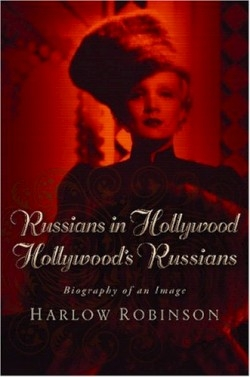It looks like you've stumbled upon a page meant to be read by our code instead of viewed directly. You're probably looking for this page.
Russians in Hollywood, Hollywood's Russians
Biography of an Image
Hollywood’s fast and loose versions of all things Russian, from its literature to its history, might be more amusing if it were not the sole source of information about the country for so many people.
Russians in Hollywood looks at how the film industry shaped American ideas about Russia and the USSR, and also explores the contributions of Russian émigré artists in Hollywood. Robinson, the Matthews Distinguished Professor of Modern Languages and History at Northeastern University and author of biographies of Sergei Prokofiev and Sol Hurok, describes how the see-sawing relations between the two superpowers are mirrored in the portrayal of Russians/Soviets in popular films.
For example, the light-hearted Balalaika of 1939, starring Nelson Eddy, seemed to be saying that “no personal or ideological issue is so vexing that it cannot be solved by a rousing chorus or a foot-tapping peasant tune.” By the time it was released, however, the USSR’s popularity had plummeted, and the film didn’t do well. Two years later, when the US and the USSR became allies, Hollywood’s portrayal of the USSR underwent another transformation. In Song of Russia and Days of Glory, Robinson writes, “while the Soviet/Russian characters speak fine English, to minimize the perception of ‘otherness,’ the German characters speak either German or heavily accented English.”
Also included are biographical sketches of some of the more prominent Russian theatre people who passed through Hollywood. Among them actors Maria Ouspenskaya, Akim Tamiroff, and Yul Brynner; Konstantin Stanislavly, who popularized Method Acting; ballet dancers-turned-actors Mikhail Baryshnikov and Alexander Godunov, and many others. In Hollywood, accents were usually considered interchangeable. The Swedish Greta Garbo played a number of Russian roles, while Russian actors often played Spaniards.
Robinson’s plot summaries of dozens of movies—from blockbusters like Dr. Zhivago, Red and Gorky Park, to sleepers such as Forty Shades of Blue—are entertaining and insightful, and his assured style guides the reader effortlessly through a sometimes convoluted subject. The depth of his research should also make this book useful for cultural historians.
Disclosure: This article is not an endorsement, but a review. The publisher of this book provided free copies of the book to have their book reviewed by a professional reviewer. No fee was paid by the publisher for this review. Foreword Reviews only recommends books that we love. Foreword Magazine, Inc. is disclosing this in accordance with the Federal Trade Commission’s 16 CFR, Part 255.
